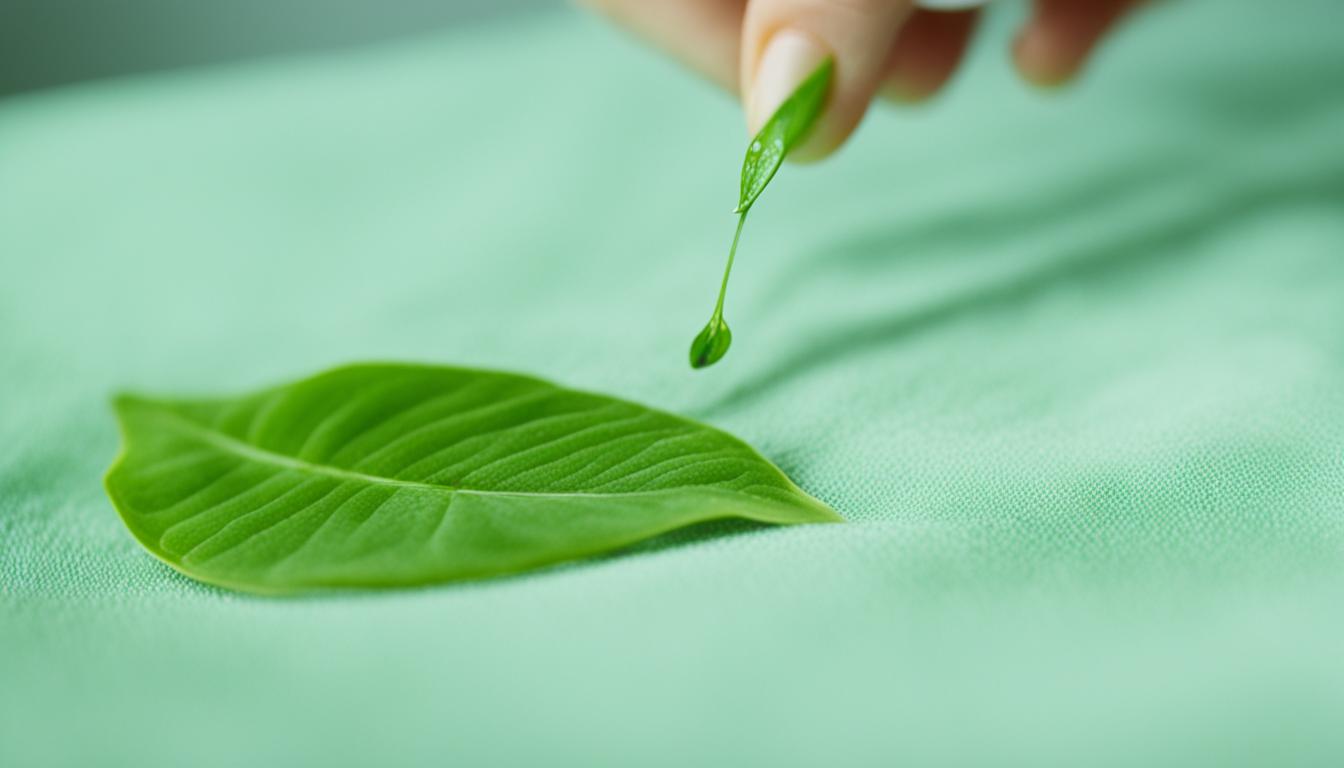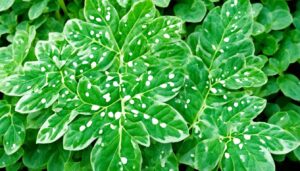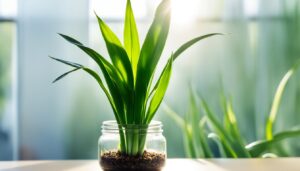Keeping your houseplants clean not only makes them more visually appealing, but it also plays a vital role in their overall health and growth. Dust, dirt, and debris can accumulate on the leaves of your indoor plants, hindering their ability to absorb sunlight and essential nutrients. By incorporating a regular cleaning routine, you can ensure that your houseplants remain vibrant and thriving.
But where do you start? In this article, we will guide you through the process of cleaning your houseplant leaves, from common methods to DIY cleaning solutions and special care for different types of plants. Whether you’re a seasoned plant parent or just starting your indoor gardening journey, these tips and techniques will help you give your houseplants the attention they deserve.
Key Takeaways:
- Regularly cleaning your houseplant leaves promotes optimal growth and overall plant health.
- Dust and debris can hinder photosynthesis and nutrient absorption, so it’s important to keep your houseplants clean.
- Common cleaning methods include wiping with a damp cloth and showering your plants with lukewarm water.
- DIY leaf cleaning solutions, such as a soap and water mixture or vinegar and water, are safe and effective alternatives to commercial products.
- Different types of plants may require specific cleaning techniques, so be sure to research and understand the needs of your specific plants.
Introduction
Welcome to the world of houseplant care, where clean leaves are the secret to vibrant, healthy plants. In this section, we’ll delve into the importance of cleaning your houseplant leaves and how it contributes to the overall well-being and beauty of your plants.
Clean leaves offer numerous benefits. They ensure that your plants can photosynthesize effectively, absorbing the essential sunlight and converting it into energy for growth. Clean leaves also promote better air circulation around your plants, preventing the buildup of dust and debris that could attract pests or hinder their growth.
Now that we understand the benefits of clean leaves, let’s explore the different methods and solutions available to help you maintain optimal leaf cleanliness.
Benefits of Clean Leaves
Clean leaves offer numerous benefits to your houseplants. They help the plants photosynthesize more effectively, ensuring they receive the necessary nutrients for growth. Clean leaves also allow better airflow and prevent the buildup of dust and debris, which can attract pests and hinder plant health. Moreover, clean leaves enhance the overall appearance of your plants, making them more attractive and vibrant.
Having clean leaves is essential for the health of your houseplants. When leaves are free from dirt and dust, they can absorb and process sunlight more efficiently through photosynthesis. This process is crucial for plants as it converts light energy into chemical energy, providing them with the necessary nutrients for growth.
Clean leaves also ensure better airflow around your plants. Dust and debris can accumulate on the leaves, blocking the natural flow of air. Adequate airflow is important for plant respiration, as it allows the exchange of gases such as oxygen and carbon dioxide. By keeping the leaves clean, you create a healthier environment for your plants to thrive.
In addition to promoting plant health, clean leaves have aesthetic advantages. Dirty and dusty leaves can make your plants look dull and lifeless. On the other hand, clean leaves enhance the overall appearance of your plants, making them more visually appealing. When your houseplants have shiny and vibrant leaves, they become decorative elements in your home or office, adding beauty and freshness to your space.
Common Cleaning Methods
In this section, we will explore the most common methods used to clean houseplant leaves. There are several effective techniques for keeping your plant leaves clean and healthy.
Wiping with a Damp Cloth
One simple and effective method is to wipe the leaves with a damp cloth. This helps remove dust, dirt, and debris that may have accumulated on the surface of the leaves. To do this, take a clean, soft cloth and dampen it with water. Gently wipe each leaf, paying attention to both sides, to ensure thorough cleaning. Make sure to use a gentle touch to avoid damaging the delicate leaves.
Showering Your Houseplants
Another method is to give your houseplants a good shower. Place your plants under a lukewarm water source, such as a showerhead or faucet. Allow the water to run over the leaves, gently rinsing away any dirt or dust. This method not only cleans the leaves but also provides hydration, mimicking a natural rain shower. Be sure to adjust the water pressure to a gentle flow to prevent damage to the leaves.
If you have particularly large or heavy potted plants that are difficult to move, you can use a handheld shower attachment or a watering can with a fine shower spray to shower the leaves.
Remember, it’s important to only clean the leaves of plants that tolerate water on their foliage. Some plants, like succulents or those with fuzzy or hairy leaves, are more sensitive to wet conditions and may be best cleaned using alternative methods.
Now that you’re familiar with these common cleaning methods, you can choose the one that suits your plant’s needs and ensure that your houseplant leaves stay clean and healthy.
DIY Leaf Cleaning Solutions
Many people prefer to use DIY leaf cleaning solutions to avoid the potential harm of commercial leaf shine products. In this section, we will provide recipes for homemade leaf cleaning solutions that are safe and effective for your plants.
Soap and Water Solution
A simple soap and water solution is a gentle and effective way to clean your houseplant leaves. To make this solution, combine a few drops of mild liquid dish soap with warm water in a spray bottle. Shake the bottle gently to mix the solution. Spray the solution onto a soft cloth or sponge, and then gently wipe the leaves, taking care not to apply too much pressure. Rinse the leaves with plain water or wipe them with a damp, clean cloth to remove any soap residue. This solution is suitable for most houseplants and can be used regularly to keep your leaves clean and shiny.
Vinegar or Lemon Juice and Water Mixture
Another effective DIY leaf cleaning solution involves using a mixture of vinegar or lemon juice and water. These natural acids help remove dust, dirt, and mineral deposits from the leaves. To make the solution, mix equal parts of either white vinegar or freshly squeezed lemon juice with water in a spray bottle. Shake the bottle to combine the ingredients. Spray the solution onto a soft cloth or sponge and gently wipe the leaves. Avoid using this solution on plants that are sensitive to acidic substances, such as ferns or certain orchids. Rinse the leaves with plain water or wipe them with a damp cloth to remove any residue. Use this solution sparingly, as the acidic properties can be too harsh for some plants if used too frequently.
Using these DIY leaf cleaning solutions allows you to maintain the cleanliness of your houseplant leaves without exposing them to potentially harmful chemicals. Plus, they are cost-effective and readily available, making them a convenient choice for plant lovers.
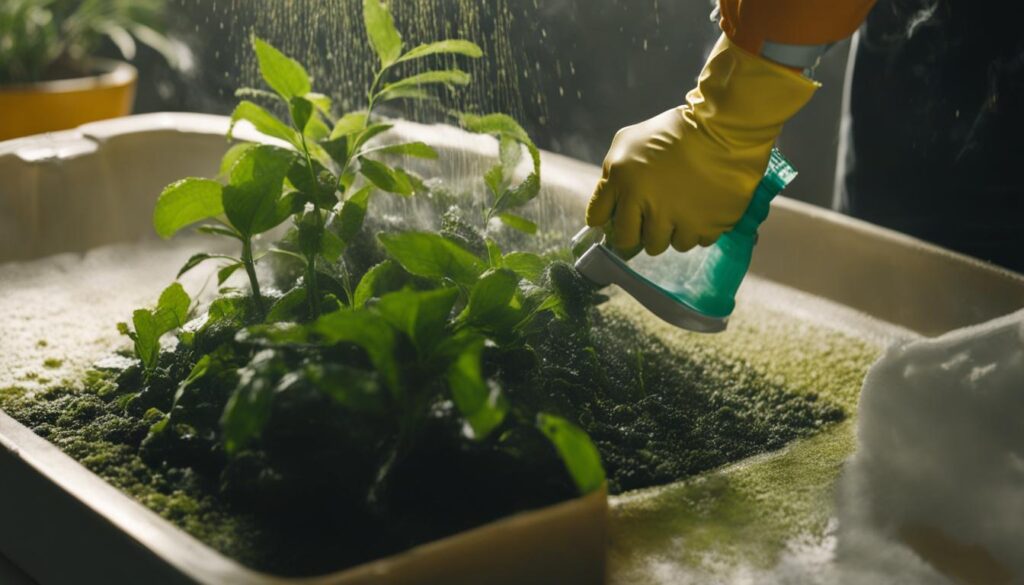
Special Care for Different Types of Plants
Different types of plants require different cleaning techniques and care. It’s important to understand the specific needs of each type of houseplant to ensure their leaves are cleaned properly without causing any damage. In this section, we will discuss how to clean the leaves of various common houseplants, such as ferns, orchids, and palms. By following these instructions and tips, you can provide the appropriate care and cleaning method for each type of plant, promoting their health and vitality.
“Understanding the specific cleaning requirements of different houseplants is crucial for maintaining their overall health and ensuring they thrive.”
Ferns:
When cleaning fern leaves, it’s important to be gentle as they are delicate and sensitive. Avoid using too much pressure or harsh cleaning solutions that could damage the leaves. Here’s a step-by-step guide for cleaning fern leaves:
- Gently mist the leaves with lukewarm water to loosen any dust or debris.
- Using a soft, damp cloth or sponge, wipe the leaves gently. Be sure to reach both sides of each leaf.
- Inspect the leaves for any pests or signs of disease while cleaning. Remove any unwanted visitors or affected leaves.
- Allow the leaves to air dry naturally.
Orchids:
Cleaning orchid leaves requires careful attention to avoid damaging their sensitive foliage. Follow these steps for effectively cleaning orchid leaves:
- Fill a spray bottle with lukewarm water.
- Gently mist the leaves with water, making sure to cover both sides of each leaf.
- Use a soft cloth or sponge to gently wipe the leaves, removing any visible dust or debris.
- Inspect the leaves for any pests or signs of disease. Take necessary measures to address any issues.
- Allow the leaves to air dry before placing the orchid back in its proper location.
Palms:
Cleaning palm leaves is relatively straightforward, but it’s important to handle their large and sturdy leaves with care. Here’s how to clean palm leaves effectively:
- Fill a spray bottle with lukewarm water.
- Mist the leaves generously, ensuring that both the top and bottom surfaces are covered.
- Use a soft cloth or sponge to wipe the leaves, removing any visible dust or dirt.
- Inspect the leaves for any pests or signs of disease. Take appropriate action if necessary.
- Allow the leaves to air dry naturally.
Remember, these are general guidelines for cleaning specific types of houseplants. Always refer to specific care instructions for each plant to avoid causing any harm. With proper cleaning techniques, you can keep your houseplants healthy and thriving.
Tools and Equipment
To effectively clean your houseplant leaves, you’ll need the right tools and equipment. Here are some essential items:
- Soft cloths: Use these to gently wipe the leaves to remove dust and debris.
- Sponges: Soft sponges can be used for larger leaves or to clean multiple plants at once.
- Brushes: Soft bristle brushes are great for reaching crevices and difficult-to-clean areas.
- Spray bottles: Fill a spray bottle with lukewarm water or a homemade cleaning solution for easy application.
When using these tools, remember to be gentle to avoid causing any damage to your plants. Take your time and pay attention to each leaf, ensuring a thorough and effective cleaning process.
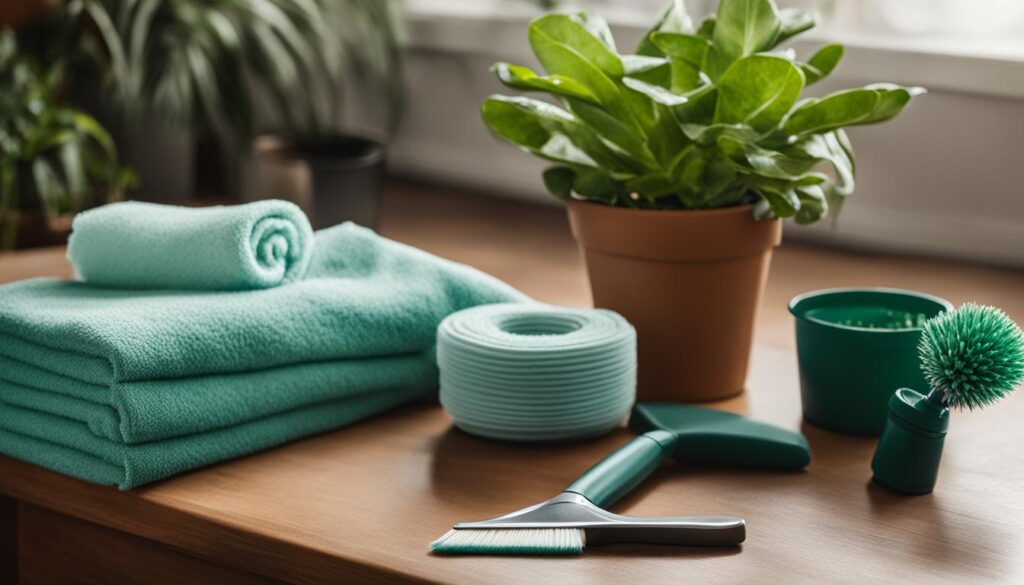
Troubleshooting Leaf Cleaning Issues
Sometimes, you may encounter issues or challenges when cleaning your houseplant leaves. In this section, we will address common leaf cleaning issues and provide troubleshooting tips. Whether it’s stubborn stains, sticky residue, or delicate leaves, we will guide you on how to overcome these challenges and ensure that your plants’ leaves are clean and healthy.
If you come across stubborn stains on your houseplant leaves, don’t worry. Try using a mild dish soap and water solution to gently scrub the stained area with a soft cloth or sponge. Be sure to rinse the leaves thoroughly to remove any soapy residue.
For sticky residue, such as sap or insect secretion, you can use rubbing alcohol or neem oil. Apply a small amount to a cloth and gently wipe the affected areas. Avoid using excessive force to prevent damaging the leaves.
If you have delicate leaves that can easily tear or bruise, opt for a gentle cleaning method. Use a soft brush, such as a clean toothbrush or a makeup brush, to dust off the leaves. You can also try using a handheld air blower or a can of compressed air to blow away any debris.
Remember, it’s important to be patient and gentle when dealing with leaf cleaning issues. Always test any cleaning solutions or methods on a small, inconspicuous area of the leaves before applying them to the entire plant. By following these troubleshooting tips, you can effectively clean your houseplant leaves and keep them looking their best.
Frequency and Timing
Cleaning the leaves of your houseplants is an essential part of their maintenance. Regular leaf cleaning ensures the cleanliness and health of your plants. In this section, we will discuss the recommended frequency for cleaning houseplant leaves and the best time to perform this task. By following these guidelines, you can keep your houseplants looking fresh and vibrant.
It is generally recommended to clean your houseplant leaves once a month. This frequency allows for the removal of dust, dirt, and other debris that may accumulate on the leaves. However, certain factors such as the location of your plants, the surrounding environment, and the type of plant can affect the cleaning frequency.
If your houseplants are placed in a dusty or smoky environment, they may require more frequent cleaning. Similarly, plants placed near air vents or in high-traffic areas may accumulate more debris and may need to be cleaned more often. On the other hand, plants in cleaner environments may require less frequent cleaning.
In addition to regular cleaning, it is important to clean the leaves of your houseplants whenever you notice visible dirt, dust, or pests. Promptly addressing these issues helps maintain the overall health and appearance of your plants.
When it comes to timing, it is generally best to clean your houseplant leaves in the morning or early afternoon. This allows the leaves to dry before evening, reducing the risk of fungal growth or water-related issues. Avoid cleaning the leaves during the hottest part of the day to prevent water droplets from causing sunburn or leaf damage.
Overall, establishing a regular cleaning routine and paying attention to the specific needs of your houseplants will help ensure their leaves remain clean, healthy, and vibrant.
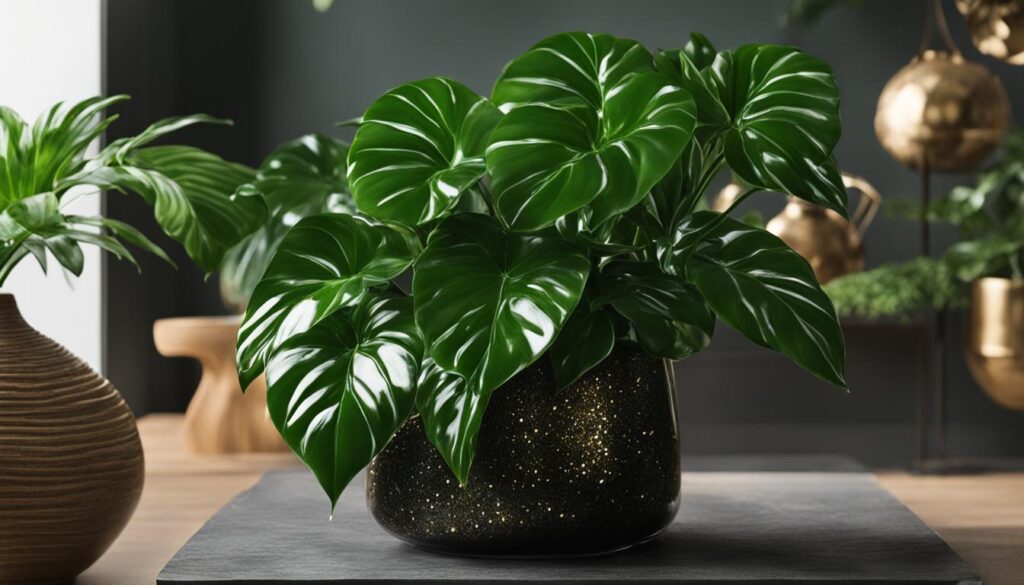
Leaf Cleaning and Plant Health
In addition to enhancing the appearance of your houseplants, cleaning their leaves also plays a vital role in their overall health. When your houseplant leaves are clean and free from dust and debris, they can perform essential functions more effectively, contributing to their overall well-being.
One key benefit of clean leaves is the improvement in photosynthesis. The process of photosynthesis allows plants to convert sunlight into energy, which is essential for their growth and development. When the leaves are clean, they can absorb sunlight more efficiently, maximizing the amount of energy produced. This, in turn, promotes optimal plant growth.
Clean leaves also facilitate better plant respiration. Just like humans, plants need to breathe to survive. They take in carbon dioxide and release oxygen through tiny pores called stomata on their leaves. When these stomata are clogged with dust or debris, the exchange of gases becomes less efficient. By cleaning the leaves regularly, you can ensure that the stomata remain clear and unobstructed, allowing for proper respiration and nutrient absorption.
Furthermore, clean leaves help prevent the occurrence of pests and diseases. Dust and debris on the leaves can attract pests such as spider mites, aphids, and mealybugs, which can harm your plants. By keeping the leaves clean, you create an unfavorable environment for these pests, reducing the risk of infestation. Additionally, cleaning the leaves allows you to inspect them closely for any signs of disease or infection, enabling early detection and treatment.
By prioritizing leaf cleaning as part of your plant care routine, you can promote the overall health and vitality of your houseplants. Cleaner leaves mean better photosynthesis, improved respiration, and enhanced pest and disease prevention. So, make it a habit to regularly clean the leaves of your houseplants to ensure their optimal health and growth.
Conclusion
In conclusion, maintaining clean leaves is crucial for the optimal growth and health of your houseplants. Throughout this article, we have discussed the benefits of clean leaves, common cleaning methods, DIY leaf cleaning solutions, special care for different types of plants, tools and equipment needed, and troubleshooting leaf cleaning issues.
By incorporating regular leaf cleaning into your plant care routine, you can ensure that your houseplants thrive with shiny, healthy leaves. Clean leaves enhance photosynthesis and ensure proper nutrient absorption, leading to overall plant growth. They also prevent the buildup of dust and debris, promoting better airflow and reducing the risk of pests and diseases.
Remember to follow the recommended cleaning techniques and frequency based on your plants’ specific needs. Whether you choose to wipe the leaves with a damp cloth, shower them with water, or use homemade leaf cleaning solutions, make sure to be gentle and cautious to avoid causing any damage.
By following the tips and techniques provided in this article, you can maintain the cleanliness and health of your houseplant leaves, creating an inviting and vibrant indoor environment for your plants to thrive.
For more valuable Expert Tips check out our comprehensive Houseplant Guide to Tips for Indoor Plant Care.
If you happen to be nearby, stop in at The Landscape Connection and say Hi. Michelle and I would love to meet you.
FAQ
Why is it important to clean houseplant leaves?
Clean leaves contribute to the overall health and appearance of your plants. They promote effective photosynthesis, prevent dust and debris buildup, enhance airflow, and make your plants more attractive and vibrant.
What are the most common methods used to clean houseplant leaves?
The most common methods include wiping the leaves with a damp cloth and showering your houseplants with lukewarm water.
Are there any DIY leaf cleaning solutions?
Yes, you can make homemade leaf cleaning solutions using simple soap and water, or a mixture of vinegar or lemon juice with water.
How do I clean the leaves of different types of houseplants?
Different types of plants may require different cleaning techniques. For specific instructions on cleaning ferns, orchids, palms, and other common houseplants, refer to our section on “Special Care for Different Types of Plants.”
What tools and equipment do I need to clean houseplant leaves?
You may need soft cloths, sponges, brushes, and spray bottles to effectively clean your houseplant leaves.
What should I do if I encounter issues when cleaning houseplant leaves?
Our section on “Troubleshooting Leaf Cleaning Issues” provides tips for dealing with stubborn stains, sticky residue, and delicate leaves.
How often should I clean houseplant leaves?
The recommended frequency for cleaning houseplant leaves depends on the plant’s specific needs. To establish a routine, refer to our section on “Frequency and Timing.”
How do clean leaves contribute to plant health?
Clean leaves support photosynthesis, plant respiration, and prevent pests and diseases. They ensure that your plants receive the necessary nutrients and maintain optimal growth.


